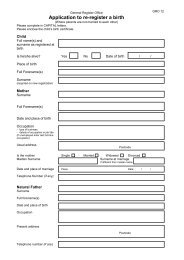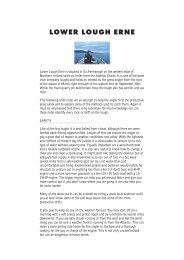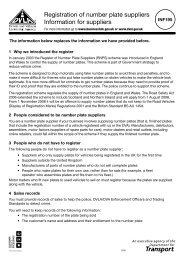an instructors guide to delivering compulsory basic training - NIDirect
an instructors guide to delivering compulsory basic training - NIDirect
an instructors guide to delivering compulsory basic training - NIDirect
You also want an ePaper? Increase the reach of your titles
YUMPU automatically turns print PDFs into web optimized ePapers that Google loves.
2. CBT Syllabus<br />
Module 3<br />
Element E - Practical on-road riding<br />
The elements must be taken in alphabetical order.<br />
As previously stated, your pupils should only move on<strong>to</strong> the next element when you<br />
are satisfied that they have learnt the necessary theory <strong>an</strong>d demonstrated the<br />
required practical skills <strong>to</strong> a safe <strong>basic</strong> level.<br />
Within each element you are free <strong>to</strong> deliver the <strong>training</strong> in the order which you feel<br />
is most appropriate for your pupils <strong>an</strong>d which matches their level of experience.<br />
You need <strong>to</strong> ensure that your pupils progress through the course at a pace that suits them.<br />
Encourage them <strong>to</strong> ask questions if they have not unders<strong>to</strong>od something.<br />
Remember; As <strong>an</strong> experienced mo<strong>to</strong>rcyclist you have valuable advice <strong>to</strong> give <strong>to</strong> learner<br />
riders <strong>an</strong>d mo<strong>to</strong>rcycle enthusiasts. Take CBT seriously <strong>an</strong>d encourage your pupils <strong>to</strong> enjoy<br />
learning safely.<br />
MODULE 1<br />
Element A<br />
Introduction <strong>to</strong> CBT<br />
This element is <strong>an</strong> introduction <strong>to</strong> CBT. You need <strong>to</strong> explain <strong>to</strong> your pupils the aims<br />
of CBT <strong>an</strong>d why it was introduced. Explain that CBT is not a test, it is a course<br />
designed <strong>to</strong> help them develop a safe <strong>an</strong>d competent level of riding before they<br />
c<strong>an</strong> ride unaccomp<strong>an</strong>ied on the road. It provides a foundation for a safe mo<strong>to</strong>rcycling<br />
life <strong>an</strong>d helps <strong>to</strong> prepare them for the mo<strong>to</strong>rcycle test.<br />
You also need <strong>to</strong> give your pupils <strong>an</strong> overview of the course content including the<br />
use <strong>an</strong>d benefits of the logbook.<br />
The time it takes <strong>to</strong> complete the course will be determined by the ability <strong>an</strong>d<br />
experience levels of your pupils. You should not move on <strong>to</strong> the next part until your<br />
pupils are ready. Within each element you are free <strong>to</strong> deliver the <strong>to</strong>pics in the order<br />
you find best suits your pupils. Every <strong>to</strong>pic must, however, be covered <strong>to</strong> the<br />
necessary level.<br />
Each pupil must demonstrate <strong>to</strong> you that they have the <strong>basic</strong> skill level <strong>an</strong>d <strong>an</strong><br />
underst<strong>an</strong>ding of each <strong>to</strong>pic. This may be through question <strong>an</strong>d <strong>an</strong>swer sessions for<br />
the theory or through practical demonstrations of their riding ability.<br />
11









